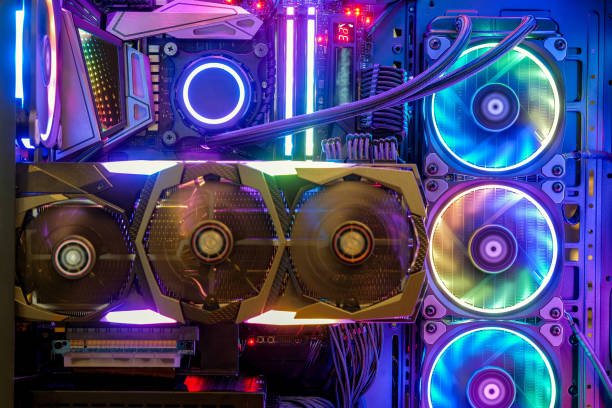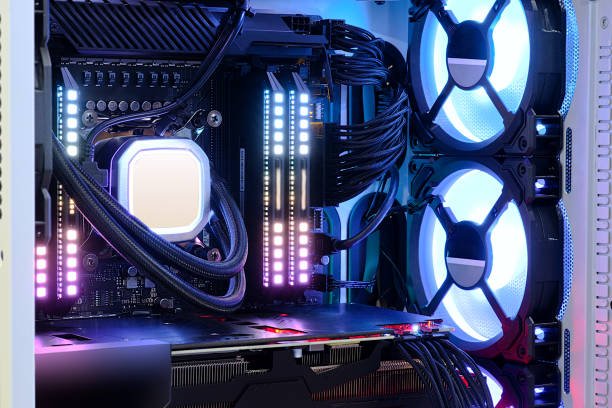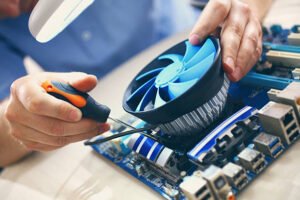How Many Fans Should a PC Have
Building or improving a PC system typically leads people to ask several questions, including, How many fans should a PC have? Airflow maintains essential importance for system health and operation success together with cooling and heating functions. Each user, regardless of gaming or graphic work, will feel some impact from the number of fans inside their PC.

This detailed guide aims to teach everything about PC fans while explaining their electrical and environmental components, such as fan positioning and fan airflow mechanics, thermal systems, and fan durability.
Why Does the Number of Fans in a PC Matter?
The first step requires defining the basic reasons behind their importance. Heat develops inside your PC starting from vital elements such as the CPU, GPU, and power supply, together with the motherboard chipset. Reprieve delays the heat buildup inside the case enclosure, thus creating different system failures such as thermal throttling along with shortened component life or sudden system shutdowns.
Fans help in two key ways:
- The system cools itself through the operation of intake fans, which extract outside fresh air.
- An exhaust fan operates by eliminating hot air from specific areas.
When gaming or under load conditions, two fans operate together to cool the PC effectively, and selecting the proper combination affects the PC’s coolest performance.
Basic PC Cooling Configurations
1. Minimal Setup (1-2 Fans)
The majority of general office and home computers can operate with a single exhaust fan positioned at the back of the case because their workload remains minimal. Here we can rephrase your inquiry about implementing two fans. Two fans set as an intake and an exhaust work best to serve their purpose even if computers are lightly used.
2. Mid-Range Setup (3-4 Fans)
This fan setup suits regular users who play games and perform tasks on Adobe Photoshop or video content or resource-heavy programs. A common configuration includes
2 intake fans at the front
1 exhaust fan at the rear
Optional top exhaust fan
The arrangement produces a very small positive pressure system that enables better air circulation out of hot air.
3. High-Performance Setup (5-7 Fans)
Having a game PC setup requires effective cooling measures because you need excessive computational power to run several virtual machines and perform 3D rendering processes. So, how many fans should a PC have for that kind of setup? A proper arrangement of five to seven fans is ideal, while their total number should not exceed seven. This could look like
- 3 front intake fans
- 2 top exhaust fans
- 1 rear exhaust
Optional bottom intake fan
The HDD bays were placed at the center of the case, while the PSU received strategic placement to blow air out from the front and rear fans.
This explanation introduces two types of pressure known as positive and negative pressure.
A thorough examination of air pressure must be conducted at the same level of importance when evaluating How Many Fans Should a PC Have.
Positive pressure: More intake than exhaust. By increasing the amount of air that enters through holes in the case, the dust accumulation decreases.
Negative pressure: More exhaust than intake. Excessive dust might enter the system, although the machine will purify hot air at increased speed.
The pressure balance remains at zero because the intake flow meets exactly with the exhaust flow. Ideal for many builds.
The lack of a specific correct method leads to choosing positive pressure systems, which create better hygiene conditions and stability.
Fan Placement and Size: Does It Matter?
Product development through design thinking involves putting How Many Fans Should a PC Have into the right places along with applying How Many Fans Should a PC Have that result from insights during new product creation. Equipment placement as a strategic decision improves airflow performance together with operational system efficiency. Here’s a basic rule of thumb:
- Front & bottom fans = intake
- Rear & top fans = exhaust
The movement of greater volumes of air with lower speeds becomes possible with larger fans, such as 140mm fans, thus producing less noise. You should use larger fans whenever possible if your case allows such fan installation.
How to Know If You Need More Fans
These indications that your PC is overheating can be identified by observing the following symptoms:
The computer system shows a persistent heat signature when CPU/GPU temperatures exceed 80 degrees Celsius.
- Loud fan noise under load
- Sudden frame drops during gaming
- Unresponsive programs or thermal shutdowns
- Any of these? I want to know if enhancing air movement in your system setup would benefit you.
Your PC will experience a major upgrade if you place two fans properly, but having just one correctly installed would still provide benefits.
Optimizing Fan Speed and Noise
After how many fans should a PC have? There exists fan control as one of the possible next steps. Results of fan speed adjustments can be achieved through the BIOS and through applications like MSI Afterburner and ASUS AI Suite. The system enables you to set temperature-based fan start points, which enables your PC to operate quietly when used lightly.
Continuous fan control works best with PWM fans instead of using DC fans to achieve better speed control capabilities while decreasing noise output.
Custom Cooling and AIOs: Does It Eliminate the Need for Case Fans?
The combination of AIO liquid coolers or custom loops calls for consideration from various types of users. The temperature reduction from CPU coolers enables fans to produce air movement from either the radiator or case.
It leads to this additional question: What other components should be utilized with liquid cooling systems? The minimum requirement for controlling your case airflow consists of 2-3 fans that need to be included in the system design.
Dust Filters and Maintenance
Airflow through ducts will remain impossible when dust completely blocks the ducts. Every air intake point on a selected case must have integrated dust filters in place. The maintenance process requires either compressed air or gentle brush cleaning after a span of three to four weeks.
You should ensure that air has sufficient circulation for effective airflow and extended component lifespan, particularly for GPUs and the power supply.
Real-World Experience from PC Builders
I have worked with computers as a user for many years and built, maintained, and optimized dozens of systems, so I can assure you there is no strict methodology, yet some common patterns exist.
I cut my Ryzen 9 processor and RTX 4080 gaming build fan count down from two to five fans, which decreased the temperature by 10°C without altering the noise level.
Users who exclusively browse YouTube videos without any other online activity are another case of system users. The system receives cool air from two fans, which eliminates the need for extra spending to reach a silent state.

Conclusion: How Many Fans Should a PC Have?
The performance aspect of how many fans a PC should have depends on the case size and intended use as well as the heat load. Here’s a quick summary:
- Basic Use: 1–2 fans
- Gaming or Content Creation: 3–4 fans
- High-End Performance Builds: 5–7 fans
The alignment of intake and exhaust needs to be balanced while selecting fan quality over number counts when possible.
FAQs
The initial question deals with how many fans inside a PC can be considered detrimental. How?
A PC contains more fans, which results in higher noise levels together with increased dust generation during insufficient fan cleaning. Having excessively complicated ventilation systems might result in decreased temperature performance compared to a system that maintains balance. Air direction represents the essential factor, not the measurement of fan speed or pressure.
A system with numerous fans Can it be made without using any fans?
Absolutely. Using massive 140mm fans with top-quality bearings and customizable fan curves will help produce a silent system. A silent computer system depends on controlling fan speed along with fan positioning and selecting an appropriate case enclosure.








